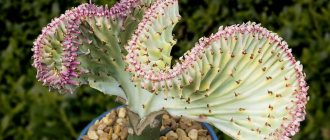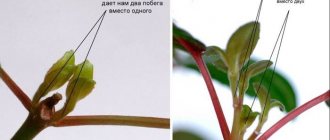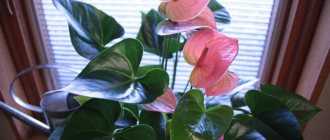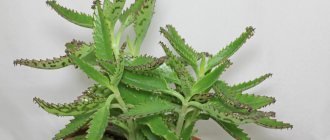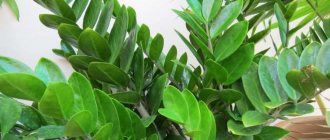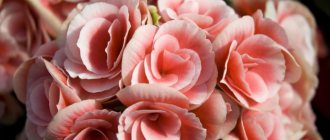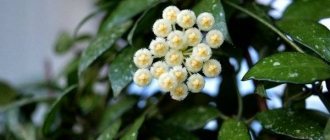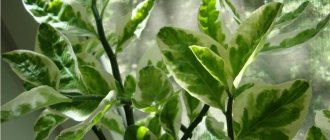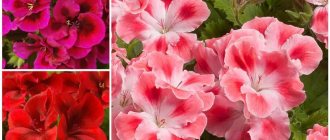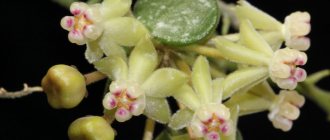Plants » Flowers
0
456
Article rating
Kira Stoletova
In modern gardening, spurge (euphorbia) is valued for its unpretentiousness and high decorative value. This crop is grown everywhere. Let's look at what varieties exist and how to care for them.
Euphorbia health benefits and harms
General characteristics of the plant
Euphorbia is a genus of herbaceous plants belonging to the Euphorbiaceae family. Latin name: Euphorbia.
Native to Madagascar and Mexican arid regions.
External features:
- has massive shoots;
- the leaves are oval, with pointed tips, of different colors - green, emerald, with a reddish, bluish or purple tint, depending on the subspecies;
- the root system can be superficial fibrous, tuberous or taprooted;
- blooms with small or medium inflorescences, there are plants with red, yellow, purple, pink or snow-white buds.
Almost all types of euphorbia, when broken, release milky juice, which is considered poisonous. When it comes into contact with the skin, it causes an allergic reaction - redness, irritation.
Purchase rules
You can purchase cultivated species of milkweed for growing in your garden or at home at any gardening store.
When buying a flower, you should carefully examine the crown - it is important that there are no signs of disease infection or mechanical injury. If the leaves do not fall off when you shake them off, it means the plant is fresh.
After purchase, indoor specimens need to be given time to adapt - they are placed in a three-week quarantine in a separate room.
Conditions of detention
For cultivation, you will need a loose, well-drained substrate with neutral acidity. You can also take a ready-made soil mixture intended for planting cacti and succulents. You can also prepare it yourself - mix turf, leaf soil, peat, brick chips and coarse sand in a ratio of 2:2:2:1:1.
This plant needs intense light throughout the year. It is placed on the south, southwest or southeast window sill. In sunny days, shade them to prevent the stems and leaves from burning.
In spring and summer, the optimal temperature in the apartment is 20-25°C. With the arrival of winter, the plant enters a dormant phase, so it requires coolness - kept at a temperature of 15-16°C.
It easily tolerates sudden increases or decreases, but does not like drafts. When the room is ventilated, it is taken to another room.
Proper care of milkweed at home
This flower is poisonous, but if precautions are taken, it can be grown at home. Milky sap provokes poisoning, so when caring for this plant you need to wear gloves and wash your hands with soap.
It is important to choose the optimal location for the plant, since the growth of some varieties can reach 3 m.
In order to grow a flower, you should pay attention to its location. Euphorbia is a light-loving plant, so you need to install the flower so that it receives daylight. Thanks to this measure, it will grow more actively and please the eye. Although milkweed can survive in any climate, the most favorable temperature for it is 25°C.
Overview of varieties
Wild growing
There are several species of milkweed that grow successfully in the wild, occupying large areas.
Euphorbia photo of a weed with spiny leaves
- Bolotny. A perennial plant 50 cm high with erect stems and oblong green leaves. Umbrella-shaped inflorescences. Distributed in desert and steppe areas.
- Weed (weed). An annual plant with a succulent stem, compact in size - about 20 cm high. The inflorescences bloom in summer and look like red bells.
- Steppe. Its homeland is the coast of the Volga and Don, and is also found on the Caucasian slopes. A perennial crop with a vertically growing stem. It can bloom in small white or yellow inflorescences throughout the summer.
- Acute (field or meadow). Prefers to grow along rivers, covering large areas of pastures, meadows, fields and forests. They can be fed to chickens, pigs, chicks, turkey poults, and goslings.
Garden
In cultivated form, gardeners use several species of spurge with different life cycles.
1. Annuals.
- Bordered (mountain snow). In nature, it is found on mountain tops and rocky slopes. A very beautiful plant during the flowering phase forms a lush white crown - light green leaves are covered with snow-white stripes. They are decorated with white bracts. Blooms in early summer and fades in late autumn.
- Variegated. Decorative deciduous species with rich green foliage and erect stems. The flowers consist of red, white or variegated petals. The height of the shoots is about 1 m.
2. Perennial plants are decorative for several years in a row and have good winter hardiness. They are often grown for cutting because they last a long time in a bouquet.
- Cypress. The height of the bush is 0.5 m. The leaves are thin, needle-shaped, green. The flowers are small, beige, red or yellow.
- Fiery (Griffith). It grows quickly, so it takes up a lot of space in the garden. The leaves are green, with the arrival of autumn they acquire a reddish-red color. The flowers are small, reddish or orange in color.
- Fischer (Pallas, man-root or man-grass). A compact plant 20-60 cm high with erect, pubescent stems, densely covered with long and narrow leaves of a light green hue with a grayish tint. Prized for its colorful blooms, which begin in May and end in July. The flowers are small, lemon-colored, collected in umbrella inflorescences.
- Rod-like (vine). Single-stem plant, shoot height - 50-60 cm. Covered along the entire length with narrow leaves of a silver-green tone. At the top, inflorescences of small yellowish buds with a diameter of 1 cm are formed.
- Poisson. A beautiful, lush shrub that has decorative green foliage with elements of beige or white. The plant does not bloom, but due to the variegation of its leaves, it is very popular in landscape design. It is planted in flowerbeds, mixborders, and rock gardens.
Indoor
Perennial indoor species are valued not only for their decorative flowering, but also for their beautiful foliage, which delights with plain or variegated colors all year round.
Euphorbia ordinary photo
- Head of a jellyfish. An unusually shaped succulent with a short and thickened stem, with age it acquires numerous side shoots that develop in different directions. It is grown in hanging flowerpots and flowerpots - the green tentacle branches hang beautifully, creating the effect of a curly head.
- Variegated. One of the most common African succulents, which is also found in the wild in America, as well as on the island of Madagascar. In nature it reaches gigantic sizes - up to 10 m, in cultivated form - up to 2 m. The stems are fleshy, consisting of 5 ribs. The shoots are 5-7 cm thick. Short spines (3-4 mm long) develop on the edges.
- Bristling. A plant with a well-branched crown. The stems develop in an upright position, abundantly covered with rudimentary leaves of rich green color.
- Triangular (triangular). This species with a bizarre shape has massive, well-branched, triangular stems. The edges of the ribs are prickly - spines of a grayish or yellow-brown tone.
- Large-horned. Develops triangular stems with small foliage at the top, which crumbles with age. Shoot height is 40-50 cm. Native to Mexico and Australia.
- Tirukalli (finger). A succulent consisting of numerous finger shoots. There are no thorns or leaves on their surface. With good care at home, it can bloom magnificently with small yellowish flowers.
- Canary. Scientific name: euphorbia canariensis. This is a large spurge in the form of a bush or tree, in natural conditions it reaches a height of 12 m. In cultivated form - 1-2 m. The stems are massive, four or five-sided. The ribs contain small tubercles. The diameter of the shoots is 5-6 cm. Rudimentary type leaves develop under each convexity. The stems are covered with thorns about 0.5 cm long.
- White-veined. The plant is recognized by its unusual leaves - they are green and contain clearly defined transverse veins of white color.
- Mile (brilliant). The ornamental plant is popularly called crown of thorns. Forms a dense crown with lush branching. Beautiful red or scarlet flowers bloom at the top of the stems. The shoots are covered with thorns.
- Poinsettia. Other names: most beautiful spurge, Christmas star. It is bought on the eve of Catholic Christmas. A flower with bright red stipules forming large inflorescences at the top of the shoots decorates any interior. This plant is an annual and can bloom in December.
- Fat. The plant is in the shape of a cactus, 30 cm high and 10 cm in circumference. The stem is ribbed, divided into several weakly defined edges. Buds form on each, and eventually leaves.
- Lactea. A beautiful plant with emerald foliage and colorful blooms that, with good care, last throughout the year.
How to make milkweed bloom
- Diamond frost. The crown resembles a hat consisting of thin emerald stems covered with small white flowers.
- Ordinary (ordinary). This species has a compact crown - the stems are erect, with medium foliage. The leaves are green, oval with pointed tips. It blooms with small yellow or white buds collected in umbrella inflorescences.
- Myrsinites climber. A plant with erect stems covered with long dark green leaves. The flowering is inconspicuous - the buds are small, pale yellow or white. Valued for its decorative leaves, which do not fall off all year round.
- Volodushkolistny (hare's ears, in Latin - bupleurifolia). This is a perennial succulent with lanceolate-spatulate leaves, 5-7x3 cm in size and a thick short stem 20 cm high, 7 cm in circumference. The surface of the shoot is covered with brown, hard scales. The leaves develop at the top, forming a loose rosette. In appearance it resembles prostrate spurge. In the winter season the foliage falls.
- Almond purpurea. Botanical name: euphorbia amygdaloides purpurea. One of the most decorative varieties with dark purple, erect stems, densely covered with narrow leaves (length 8-10 cm, width 1 cm). The color of the leaf plate is emerald with a burgundy tint. Height - from 40 to 60 cm. At the top of each stem, several small inflorescences are formed, consisting of light green or light green, rounded petals.
- Comb-costal. Medium height - up to 50 cm, forms tiny white flowers framed by red or pink bracts. The ridge-shaped stems are tetrahedral.
How to propagate euphorbia by cuttings
Propagation by cuttings is best done in late May or early June. You need to separate a healthy shoot from a young branch and let the poisonous juice drain. The cut must be treated with activated carbon. The cut shoot is left to dry for a couple of days.
After this time, the sprout is planted in prepared soil and watered well. After a month, the cutting will take root and can be transplanted into a suitable container or into open ground. Care for young Euphorbia milkweed plants at home is the same as for adults.
Euphorbia plants can be easily propagated from cuttings.
Landing
For planting, use a container that is not too deep, but wide, since almost all species have an extensive superficial root system.
Why did the spurge suddenly turn yellow?
A pot made of ceramic, clay or plastic with drainage holes in the bottom is suitable.
Technology:
- Expanded clay and fertile soil are filled in.
- The roots are lowered, covered with soil to the top, compacted, and watered with water at room temperature.
- Install a support so that the plant takes a vertical position.
Description of the plant
Euphorbia lactea Cristata, also known in foreign literature as Elkhorn, is a form of milkweed with modified stem tips, similar to a curved wavy ridge, or coral branch. The classic subspecies grows up to 90 cm and has a juicy dark green color. It grows very slowly - this is one of the reasons for growing on a rootstock.
The wild species grows in the humid tropical zone of South Asia: India, Sri Lanka and Pakistan. It is cultivated in similar climatic conditions in other parts of the Earth: in Florida (USA), in Southeast Asia, on the Sunda Islands. There are even landings in Ukraine. Sometimes it forms impenetrable thorny thickets, growing up to 5-6 m high. On its basis, euphorbia lactea forma Cristata, a subspecies with deformed stems, was bred.
Attention! The plant is prone to degeneration - a return to a simple natural form. To avoid this, gardeners graft decorative ridges onto a rootstock of other euphorbias, or remove wild shoots.
In recent years, a number of Cristata Variegata varieties have been developed with a variety of colors both on the stems and on the top of the ridges. Colors range from dove-white (White Ghost), to grey-green with a silvery tinge, to yellow-green, to pink and purple. The tops of the ridges tend to be brighter from the base and middle of the stems.
Features of care
In order to achieve maximum decorative value from milkweed, it is necessary to ensure proper maintenance conditions.
Watering
Water abundantly, but only after the soil has dried to a depth of 4-5 cm. If it is a cactus-like plant, watering should be scanty, since the lack of moisture is replenished due to the fleshy and succulent stems.
In winter, water very rarely - no more than once a month to avoid waterlogging and rotting of the root system.
Feeding
To increase immunity and to make it bloom, you can feed euphorbia with a mineral composition for cacti and succulents.
Apply fertilizer once a week, following the dosage indicated on the package. After this, abundant watering is carried out so that the roots quickly absorb the nutrients. In winter, during the resting phase, they do not feed.
Trimming
Euphorbia white-tipped and ribbed; cactus varieties do not need pruning. You can pinch all the rest so that they bush well.
Pinching is done on the apical shoots - carefully separate the stems to 2-3 cm in length. This will stimulate the development of new shoots.
Additionally, throughout the growing season, diseased stems and leaves are trimmed. For shaping and sanitary cutting, use a sterile and well-sharpened instrument to avoid excessive injury and infection.
Transfer rules
Be sure to replant purchased flowers, because the store-bought substrate does not contain useful substances for growth and flowering.
- Take a container 2-3 cm larger in diameter than the old flowerpot.
- Drainage is placed on the bottom and half filled with nutrient composition. Water the flower, remove it and, together with the earthen lump, transfer it to a new pot.
- If necessary, fill the soil to the top and moisten it.
The frequency of transplanting domestic euphorbias depends on age: young - every year, adults - once every 5 years.
If the roots of a plant have rotted, it also needs to be replanted, otherwise it will die.
- The flower is removed from the flowerpot, washed from the soil, the rot is cut out to healthy tissue, and dipped in a fungicide solution for an hour.
- Then they are dried, the cut areas are sprinkled with charcoal, and they are planted in a new container with a sterile soil mixture.
Watering and fertilizing
To water Euphorbia, you need to let the water sit for several days. You should not water with chlorinated water, otherwise white stains may appear on the trunk or leaves. The water temperature for irrigation should be room temperature. From spring to winter, water once a week, and in winter - once every 15 days or as needed. Euphorbia should be sprayed occasionally: once every 2 weeks is enough. Feed spurge once every 30 days. Fertilizers are used for both cacti and succulents.
The fertilizer must be chosen in such a way that it contains all minerals in equal quantities, otherwise one element may be missing, and the second will be too much. This may cause the leaves on the plant to turn yellow.
In spring, the flower spends nutrients on active growth. If the metabolism in the structure of a flower changes, then such a plant becomes vulnerable to pests. Various insects attack only flowers that have metabolic disorders. A healthy succulent produces a special invisible film that repels insects.
Reproduction methods
Children
This method is suitable for cactus euphorbias. Separate the baby along with the resulting roots using a sharp knife. Treat with Kornevin solution so that it takes root faster.
How to replant euphorbia in the countryside
Planted in a nutrient substrate for succulents and cacti. From such a shoot you can grow a varietal plant.
Cuttings
Method for plants with good branching. At the top, select several shoots with leaves and buds and cut them off.
The optimal length of the cuttings is 15-20 cm. At the bottom, all leaves are torn off, dipped in water for a couple of hours to allow the milky juice to drain, then dried.
They are planted when a thin film appears on the cuts. It can be rooted in a light and loose substrate of peat and sand. The seedlings are watered with warm water, covered with a transparent cap, and placed in a warm and well-lit place. Ventilate daily and moisturize if necessary.
After about 2-3 weeks, each sprout will begin to develop leaves, then the shelter is removed. They grow for another month so that the seedlings grow roots, then they are planted individually.
This method of propagation makes it possible to obtain new specimens with all the varietal characteristics of the mother plant.
Euphorbia reproduces by seeds in the wild; in private floriculture, this method is rarely practiced, because the seeds have poor germination. At home, it is difficult to create the necessary conditions for seed germination.
Rules for transplanting Euphorbia
For the plant to feel good, it must be placed in well-drained, loose soil. You can make it yourself; for this you need to take some soil, peat and sand; another option is to buy a ready-made one. Euphorbia should be planted in wide, but not very deep pots.
In order for the plant to feel good, the pot itself should be prepared.
The pot should have drainage holes to prevent water from stagnating. Expanded clay or stone chips should be placed at the bottom. After the bottom of the pot is prepared, the purchased or prepared mixture is poured into it.
In such conditions, planting will be successful and the plant will feel great.
You also need to remember that the flower should be replanted on time and correctly. As a rule, this is done in the spring. A young plant should be replanted only once a year, and an older plant should be replanted once every 2-3 years. When transplanting, you should never forget about the toxicity of milkweed; it is important to take all precautions, and after the procedure it is recommended to wash your hands with soap and water several times. The flower must be placed so that neither children nor animals have access to it.
Diseases and pests
Euphorbia contains a milky sap that releases toxins and is therefore rarely damaged by insects or infections. Infection and loss of decorative properties are possible if the plant is not taken care of.
| Diseases and pests | Diagnostics | Treatment | Prevention |
| Root rot | Appears in plants that are often overwatered with cold water. A fungal infection affects the roots, then spreads to the stems - they darken, become covered with plaque, soften and die | The flower is removed from the flowerpot; if the root is completely rotten, it is disposed of. Before this, a couple of stems are cut for rooting. A plant that is partially damaged is washed from the soil, all rot is cut out, and dipped in a fungicide solution for an hour. Dry, plant in a new pot with a sterile substrate | Adjust watering. Use room temperature water for hydration |
| Powdery mildew | Shoots and leaves are covered with a whitish powdery coating. Over time, the affected areas turn black, rot and die | The control measures are as follows: cut out all the places that have drooped and have acquired an unnatural color. You can get rid of the sore if you treat the crown with fungicides - Ridomil Gold, Skor, Topaz or Hom | Provide the required level of humidity, avoid overwatering, regularly remove yellowed, shriveled and rotten organs |
| Bacteriosis | Inhibits plant growth and flowering. Leaves and stems become covered with weeping spots that emit an unpleasant odor | It is impossible to save such a flower, because it cannot be treated | Follow the rules of care and maintenance, avoid mechanical damage |
| Mosaic | The leaves are covered with a mottled pattern of red, yellow or white spots. Chlorosis appears later. Foliage turns yellow and becomes deformed | Treatment with insecticides - Fitoverm, Topaz, Aktara | Buying healthy plants; spraying pesticides in spring and autumn |
| Alternaria blight | A fungal infection that appears as dense brown growths on the surface of leaves and stems | The diseased areas are cut out and treated with Skor, Bordeaux mixture or Ridomil gold. | Buy healthy flowers, use sterile soil for planting and replanting |
| Mealybug | It leaves a whitish coating on the surface of the leaf plate, which darkens over time. The affected areas dry out and die. This type of spurge sheds its leaves en masse | Collect all the leaves that have fallen, cut off the diseased ones. You can destroy insects with Dichlorvos, Karbofos | Application of fresh and disinfected soil for cultivation |
| Shchitovka | Brown or red growths in the form of plaques stick to the surface of the stems and leaves. They suck the juices out of them. In places of parasitism, tissues turn black and die | Cutting out all damaged parts, treating with Actellik or Fosbicide twice with an interval of 7 days | To avoid having to fight this parasite, you need to follow all the rules of care and trim non-viable organs in a timely manner. Buy healthy plants and quarantine them |
| Aphid | Light green bugs settle in colonies on the underside of leaves. They feed on their juice, which leads to curling, drying out and falling off. | Euphorbia that has turned yellow and dried out must be freed from damaged parts. Then treat with Fitoverm or Actellik | Timely removal of rotten and yellowed shoots of leaves. Buying healthy flowers |
Types of euphorbia for indoor floriculture
- white-veined;
- comb;
- Millie (brilliant);
- triangular;
- poinsettia (the most beautiful);
- large-horned;
- thirukalli;
- swollen;
- bordered.
Euphorbia comb
Comb milkweed is very similar to white-veined milkweed, so these species are often confused. The bright green stem is straight or twisted in a spiral, the shoots have 5 sides, longitudinally located thorns can reach a length of 3 cm.
The oval glossy leaves have an oblong shape, the reverse side is lighter, reflecting light. Inflorescences on short greenish-red peduncles, bracts white, less often pink, flowers greenish-yellow
Euphorbia Mile
Euphorbia Mila (brilliant) is a highly branched shrub, the branches grow up to a meter, they are widely spread and curved. This plant is often called blackthorn. The stem is round, the thorns are strong.
In the axils of the growing segments of the shoots there are inflorescences-umbrellas, containing 2-4 inconspicuous flowers, surrounded by bright bracts. On a southern windowsill, this species blooms almost without interruption, as it prefers to grow directly in the sun, sometimes shedding its leaves in winter.
In another article we described a plant called Agave.
Euphorbia domestica
Euphorbia domestic poinsettia (the most beautiful) has large ovoid leaves (up to 15 cm), reddish cuttings. Umbrella inflorescences are located at the tops.
The flowers are small, inconspicuous; bright bracts provide decoration (usually red, cream or orange in hybrid varieties). The flowering period (December, January) determines another name for the species: Christmas star.
Euphorbia tirucalli
Euphorbia tirucalli (rubber) is a branched bush with a thin, very dark stem, small leaves located at the top. You can grow a tree indoors that does not bloom. Propagated by cuttings, the juice is especially poisonous.
Euphorbia bighorn
Euphorbia is a large-horned succulent whose appearance is almost no different from a cactus. The fleshy triangular stem has 3 curved, unequal ribs, large leaves, and spines on the plates.
The inflorescences are corymbose, the yellow flowers are inconspicuous, the fruits are coral. Cuttings are used for propagation. In summer it is watered moderately, in winter almost no moisture is required.
Swollen Euphorbia
Many people perceive swollen milkweed as a cactus with eight or ten ribs. The inflorescence is formed at the tops of the shoots, the fruits develop in the presence of 2 plants of different sexes.
Polyhedral spurge
The multifaceted spurge bush is a succulent, the stem is round, fleshy, ribbed. On the ribs there are purple, almost black, spines and warty growths of brown color. Branches from the base. The inflorescences are corymbose, the bracts are red, the yellow flowers are small.
Bordered Euphorbia
Edged spurge is a herb, height from 40 to 80 cm, popular names: “Bride”, “Summer Snow”. The bush is branched, the foliage is round or pointed, with a white border. Small flowers at the tops of the shoots.
Signs and superstitions
There are several popular beliefs about this flower:
- Indoor spurge brings harmony into the house and improves mood.
- The great benefit of a flowering plant is its ability to attract happiness and tranquility.
- It should be kept in the apartment for emotional people. It pacifies, relieves tension and helps to cope with stressful situations more easily.
- White-faced infects with good energy - protects against damage, the evil eye, and the evil thoughts of ill-wishers.
- According to Feng Shui, the species with thorns should not be kept in the bedroom or children's room. It has negative magical properties and attracts discord, illness and misfortune for all family members.
Flowering and dormant period of the plant
Flowering in the house is observed quite rarely; the crop is often multi-flowered. To force the crop to throw out buds, it is recommended to properly care and adhere to the following requirements:
- suitable lighting;
- regular watering;
- regular feeding;
- periodic pruning.
Types and shape of flowers
Garden spurge (Euphorbia) - description of multi-flowered, marsh species
A large number of species of milkweed bloom with small lemon-green flowers. The flowering period lasts about 2 months, after which there comes a time of rest.
Depending on the species, flowers can be of different sizes and have different colors of petals: from white to red (in poinsettia).
Important! During the dormant period, reduce the amount of watering and completely abandon fertilizers.
Can it be eaten?
Milky sap contains toxins that can cause severe poisoning not only in children, pets, but also in adults. Therefore, to avoid poisoning, eating stems and leaves is contraindicated. It is also possible for allergies to appear on the face and skin of the hands when exposed to milk. During care, you should wear rubber gloves and a mask to protect your eyes.
Euphorbia annual pinching and growing from seeds
Among all the varieties, only one species has unique healing properties - Pallas's euphorbia. It is widely used in folk medicine. The plant contains a large amount of useful minerals, acids, and vitamins. This is a powerful immunostimulant, the healing qualities of which are manifested in the ability to eliminate many ailments:
- ovarian diseases in women;
- prostate gland in men;
- infertility, mastopathy, fibroids;
- sexually transmitted infections;
- an excellent antifungal agent that treats warts, ulcers, scabies, boils, burns and abscesses;
- effective in preventing cancer.
The leaves and stems are used to prepare alcoholic tinctures and decoctions. Fresh milky sap is poisonous, so before drinking medicine based on this plant, you should consult a doctor so as not to harm the body.
Wild, weedy spurges are used as feed for rabbits, piglets, turkeys, chickens, and cows. They are rich in vitamins and beneficial microelements, increase immunity and productivity of animals and birds.
Reproduction
Euphorbia reproduces quite easily. Most often propagated by cuttings, but there are species (for example, white-veined) that are good to grow from seeds. Globular species of euphorbia are also propagated by seeds.
- We propagate by seeds. Milkweed seeds are in a capsule that ripens and cracks. To collect the seeds, place a fabric bag over the box. After collection, the seeds are dried on paper. For germination you need to purchase a sand-peat mixture. Plants are sown in separate pots. In order not to expose young shoots to infection, the soil must be disinfected and you should not sow euphorbia with other plants. The pot is placed in a dark place until shoots emerge.
- Propagation by cuttings. Good healthy shoots are suitable for propagation by cuttings. The lower part of the branch is cleared of leaves, washed of juice, wiped dry with a cloth, the cut is dipped in ash and dried for a couple of days. Then planted in moist soil. The pot is kept away from direct sunlight.
All types of milkweed are easily propagated, you just need to choose the right method.
Variety of species
The Euphorbia genus has about 800 species. Among them there are wild and domestic plants. Domestic crops are divided into outdoor and indoor crops. The forms and appearance of plants are so diverse that one can doubt their relationship.
Types of milkweed:
- Triangular spurge. This is one of the most common types. Ease of care and unpretentiousness have made it a frequent guest not only in residential premises, but also in public institutions. The shoots of triangular milkweed are fleshy, thick, and have knobs on the edges. The color is dark green. This species grows very quickly and can reach the ceiling in 4-5 years.
- Poinsettia. This species is also called the Most Beautiful. This spurge has very beautiful leaves. The lower ones are green, and the leaves of the inflorescences can be pink, white or red. The plant blooms with small flowers at the end of December. After flowering, Poinsettia sheds its leaves and loses its attractiveness for several months. This is a very capricious species to care for.
- Resinous spurge. This milkweed looks like a cactus. It looks like a bush of dense shoots. The branches are fleshy, green with four edges. There are small spines on each edge. Quite unpretentious appearance.
- Euphorbia Mile. This milkweed looks like a mini bush. The branches are not so fleshy, with a gray tint and purple spines are located on them. The leaves are green, oblong. It blooms with small bright flowers. Young plants look very pretty, but mature ones have bald branches and look more like a thorn bush.
- White headed spurge. It has a fleshy trunk, at the end of which there is a bunch of leaves. The leaves are large, oblong with white veins. This species blooms frequently and is capable of self-sowing.
- Large-horned spurge. It has a thick triangular stem with huge paired spines. Very often this species is considered a cactus. There are small leaves on the branches, but the plant quickly sheds them. Large-horned spurge blooms with small yellow flowers.
- Milk spurge. It has dense four-rib green branches. The ribs have a white coating in the form of stripes and small paired spines. Leaves appear, but do not develop and immediately dry out.
- Euphorbia Tirukalli. It has smooth green branches, cylindrical in shape. The thickness of the branches is up to 7 mm. The leaves are bright green, straight, falling. Leaf length up to 12 mm.
- Multi-thorned spurge. Has strongly branching shoots. The branches are four-ribed, bright green with a brown edge. On mature parts of branches the ribs are diffuse. Paired gray spines are located along all ribs.
- Schoolleaf spurge. It has powerful trunks reaching 7 cm in diameter. The height of milkweed is up to 25 cm. The trunks are covered with tubercles and outwardly resemble a conifer cone. At the end of the trunk there is a bunch of thin long leaves.
